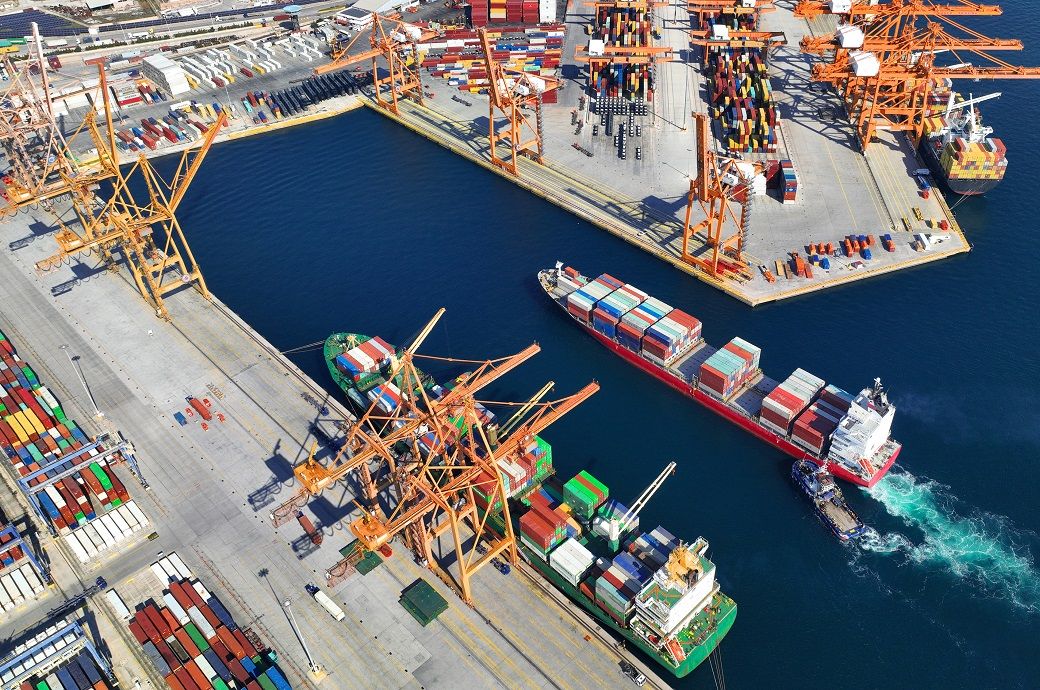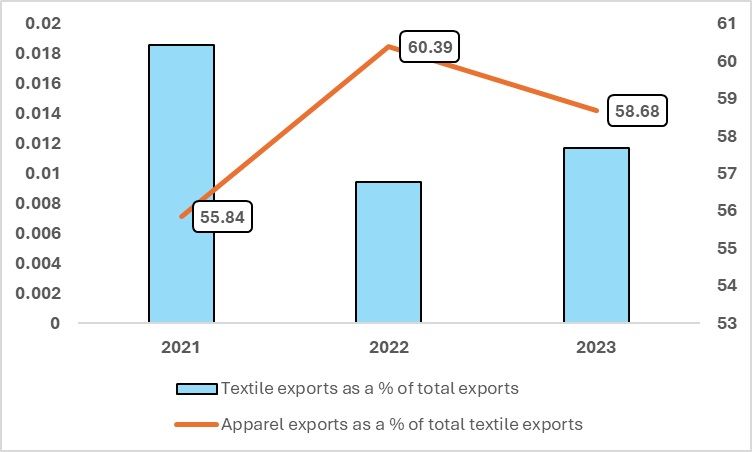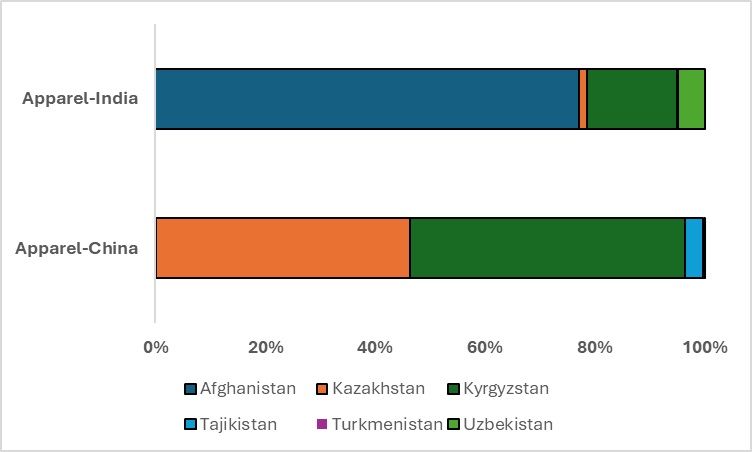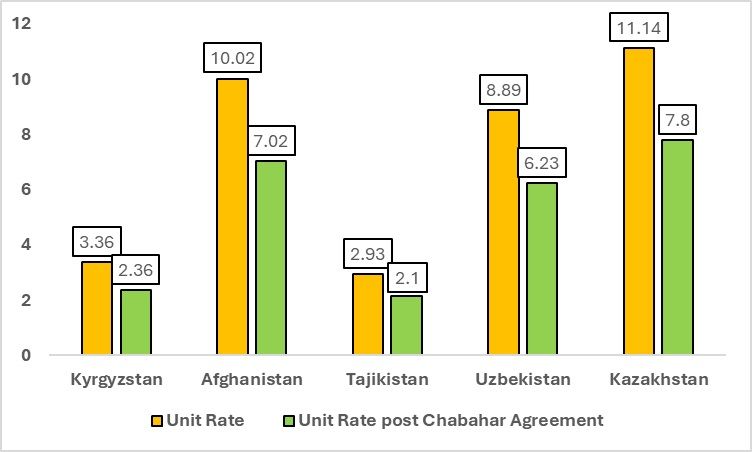
India's trade relations with Iran and Central Asia have gained prominence with the recent news of India's 10-year contract to develop and operate the Iranian port of Chabahar. Despite the looming threat of US sanctions on India's business dealings, the port is expected to have a multiplier effect on trade.
The Chabahar port acts as a pivot to the ambitious International North-South Transport Corridor (INSTC), which plans to connect India, Iran, and Russia. The INSTC is a multi-modal, cost and time-effective route from India to Northern and Western Europe. It has the potential to enhance India’s connectivity with Central Asia and the Eurasian Region, considering the geo-strategic and economic importance of all the involved countries.
India’s textile exports to Central Asia
The Chabahar agreement offers unique advantages to India. Firstly, the port is fully operated by an Indian company, India Port Global Limited, ensuring India's significant involvement in its operations. It provides India with access to Central Asian markets without relying on its neighbour Pakistan and allows it to counter China's dominance in the region.
This agreement aligns with India's long-term strategy of playing a major role in the INSTC and tapping into the high-demand markets of Russia, Eurasia, and Europe. The anticipated benefits include not only improved trade with emerging Central Asian markets but also enhanced trade with established importers such as Russia and European nations. The port is expected to handle 20 million tons of trade annually.
India has already leveraged the Chabahar Port for trade facilitation with Afghanistan. For instance, in March 2012, it used the port for the first time to ship 100,000 metric tons of wheat as part of humanitarian assistance. Subsequently, in September 2013, India received its initial shipment of Afghan goods—20 containers of dry fruits via the Chabahar Port.
As of April 2024, India has the lowest share of 0.17 per cent export in the Central Asian Republics (CARs) countries of Kazakhstan, Kyrgyzstan, Tajikistan, Turkmenistan, and Uzbekistan compared to other trading partners. Major factors affecting trade include trade barriers such as the difficult topography of being land-locked, which requires additional transaction costs and shipment time. This has led to a limited performance of CARs in the global market, and India’s lack of cheaper connectivity up till now has not helped India in making breakthrough progress in this region.
Figure 1: India's textile exports as a percentage of total exports and apparel exports as a percentage of textile exports to Central Asia

Source: United Nations Comtrade
The above graph depicts India’s textile exports as a percentage of total exports to Central Asia and apparel exports as a percentage of textile exports to Central Asia. India’s total exports to the Central Asian region—Kazakhstan, Kyrgyzstan, Tajikistan, Turkmenistan, and Uzbekistan, along with Afghanistan—totalled $1.105 billion, of which textiles occupy approximately 11.70 per cent ($129.48 million) of the exports in calendar year 2023. Notably, apparels ($76 million) occupy the highest percentage of textile exports. Even during its lowest exports in 2022, apparels occupied a substantial chunk (60 per cent) of the textile exports. Latest data suggests that the percentage share of apparels has increased from 55.84 per cent in calendar year 2021 to 58.68 per cent in calendar year 2023. The apparel industry is set to grow and be lucrative in the next few years, especially in Central Asian countries. To emerge as a global power and assume leadership in Asia, India needs to actively and strategically focus its efforts on these countries.
India vs China
According to a report by the Lowy Institute, apparel and clothing constitute a huge proportion of Chinese exports to Central Asian countries. China’s Belt and Road Initiative (BRI) has proven to be effective. Xinjiang, at the heart of Eurasia, shares borders with eight neighbouring countries, boasting a unique geographical advantage: "five gateways connecting eight nations, and one route linking Eurasia."
Xinjiang plans to enhance its trade efforts due to its favourable geographical location, robust policies, and, most importantly, the port advantages it enjoys.
With the Chabahar port acting as a main joining point in the INSTC route, which aims to compete with China’s BRI project, the port could prove to be a catalyst for the Indian textile sector, particularly the apparel sector, to enter the Central Asian markets and act as a direct competitor to Chinese exports.
Figure 2: India and China’s country composition in apparel exports to Central Asia (in %)

Source: UN Comtrade
In the above graph, Afghanistan accounts for approximately 75 per cent of India’s apparel exports to the Central Asian regions. Similarly, Kyrgyzstan along with Kazakhstan reigns as the majority importer of Chinese apparel. China also maintains trade relations with Tajikistan, which plays a small but substantial part in China’s importer list from Central Asia.
However, it is important to note that India has been able to take a multilateral approach in the Central Asia in four out of the six regions—Afghanistan, Kazakhstan, Kyrgyzstan, and Tajikistan—compared to China, which is majorly active in three nations. Despite Chinese apparel export volume ($12 billion) being significantly higher than India's ($76 million), India has been able to build pathways in the Central Asian region.
What would the agreement mean for the cost of apparel exports?
With Chabahar, the transport time is expected to reduce by 40 per cent, along with the freight cost reducing by 30 per cent (FIEO). Due to lower freight costs, the exporter might reduce overhead costs, resulting in cheaper textile commodities. As Central Asia is a developing region, cheaper but quality products can prove to be more competitive in the market. Below is a graph depicting the pre and post-Chabahar agreement unit prices of apparel from India to Central Asian countries.
Figure 3: India’s unit rate (apparel) current trend vs expected trend post Chabahar agreement (in $)

Source: TexPro, author’s calculations
*Please note that Turkmenistan is not included due to lack of data availability
*Unit rate prices are subject to change
A 30 per cent reduction in freight cost and its effect on unit cost via direct cost is depicted above. The prices are subject to change depending on the outlook of these countries and the capability of the Chabahar port in Iran to operate systematically in the Central Asian region. Cheaper exports would mean better competitiveness in the Central Asian markets. Given the dominance of China's apparel industry in the region, India must enhance efficiency across its supply chains. Reducing freight costs would be a significant step in this direction.
Future Outlook
India is in talks for a free trade agreement with the Eurasian Economic Union (EAEU) bloc, which includes Armenia, Belarus, Kazakhstan, Kyrgyzstan, and Russia. The Free Trade Agreement would be a step in the right direction for India to strengthen its trade relations with the Central Asian countries and the surrounding region. The Free Trade Agreement would also be beneficial to Indian textile exports, as they would be able to create an impact in Kazakhstan and Kyrgyzstan, two countries where China has a stronghold.
The Chabahar port would also prove to be a winner for Indian exports, as it would be a major fulcrum to the INSTC from India to Russia. According to the Global Trade Research Initiative (GTRI), the corridor will bring down the time to transport goods to Europe to 25 days, from around 45 days taken through the Suez Canal. Hence, the corridor would not only include Tajikistan and Turkmenistan, two countries that Indian textile exporters can explore, but also would be the gateway to key importers such as Russia and Europe.
ALCHEMPro News Desk (NS)
Receive daily prices and market insights straight to your inbox. Subscribe to AlchemPro Weekly!